Cohen I.M., Kundu P.K. Fluid Mechanics
Подождите немного. Документ загружается.


702 Aerodynamics
The total lift force on a wing is then
L =
s/2
−s/2
ρU dy =
π
4
ρU
0
s. (15.19)
To determine the downwash, we first find the derivative of equation (15.18):
d
dy
=−
4
0
y
s
s
2
− 4 y
2
.
From equation (15.13), the downwash at y
1
is
w(y
1
) =
1
4π
s/2
−s/2
d
dy
dy
y
1
− y
=
0
πs
s/2
−s/2
ydy
(y − y
1
)
s
2
− 4 y
2
.
Writing y = (y − y
1
) + y
1
in the numerator, we obtain
w(y
1
) =
0
πs
s/2
−s/2
dy
s
2
− 4 y
2
+ y
1
s/2
−s/2
dy
(y − y
1
)
s
2
− 4 y
2
.
The first integral has the value π/2. The second integral can be reduced to a standard
form (listed in any mathematical handbook) by substituting x = y − y
1
. On setting
limits the second integral turns out to be zero, although the integrand is not an odd
function. The downwash at y
1
is therefore
w(y
1
) =
0
2s
, (15.20)
which shows that, for an elliptic circulation distribution, the induced velocity at the
wing is constant along the span.
Using equations (15.18) and (15.20), the induced drag is found as
D
i
=
s/2
−s/2
ρw dy =
π
8
ρ
2
0
.
In terms of the lift equation (15.19), this becomes
D
i
=
2L
2
ρU
2
πs
2
,
which can be written as
C
D
i
=
C
2
L
π
,
(15.21)
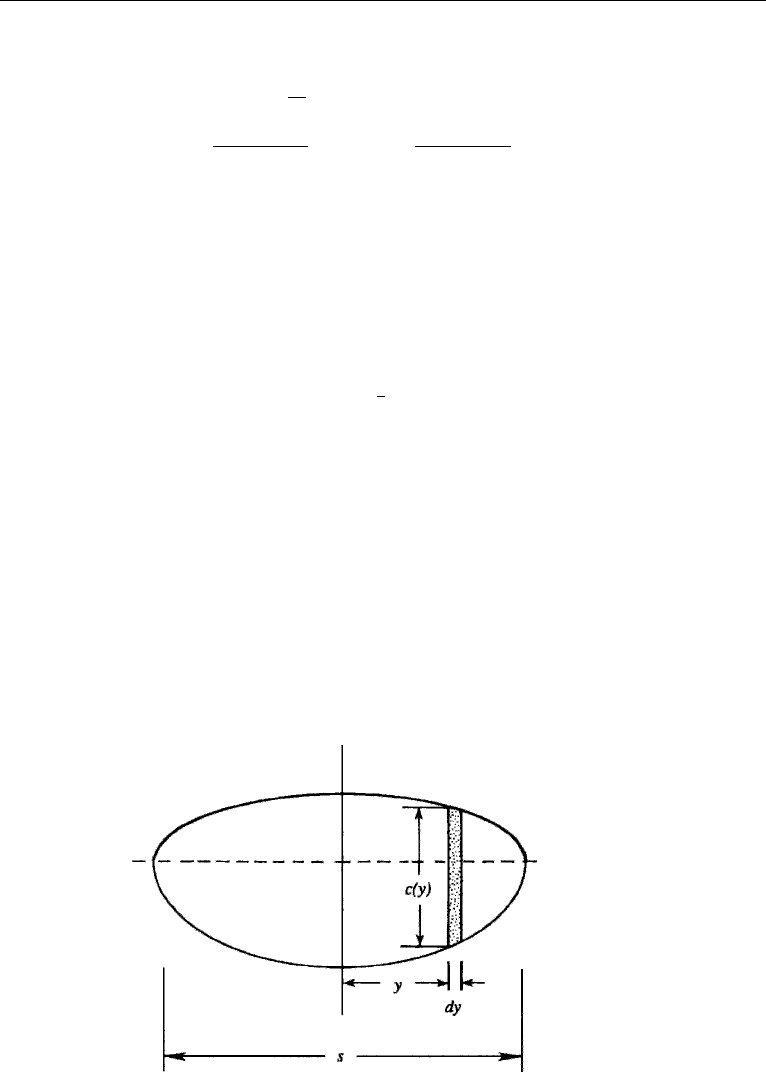
11. Results for Elliptic Circulation Distribution 703
where we have defined the coefficients (here A is the wing planform area)
≡
s
2
A
= aspect ratio
C
D
i
≡
D
i
(1/2)ρU
2
A
,C
L
≡
L
(1/2)ρU
2
A
.
Equation (15.21) shows that C
D
i
→ 0 in the two-dimensional limit →∞. More
important, it shows that the induced drag coefficient increases as the square of the
lift coefficient. We shall see in the following section that the induced drag generally
makes the largest contribution to the total drag of an airfoil.
Since an elliptic circulation distribution minimizes the induced drag, it is of inter-
est to determine the circumstances under which such a circulation can be established.
Consider an element dy of the wing (Figure 15.25). The lift on the element is
dL = ρU dy = C
L
1
2
ρU
2
cdy, (15.22)
where cdy is an elementary wing area. Now if the circulation distribution is elliptic,
then the downwash is independent of y. In addition, if the wing profile is geomet-
rically similar at every point along the span and has the same geometrical angle of
attack α, then the effective angle of attack and hence the lift coefficient C
L
will be
independent of y. Equation (15.22) shows that the chord length c is then simply pro-
portional to , and so c(y) is also elliptically distributed. Thus, an untwisted wing
with elliptic planform, or composed of two semiellipses (Figure 15.25), will generate
an elliptic circulation distribution. However, the same effect can also be achieved with
nonelliptic planforms if the angle of attack varies along the span, that is, if the wing
is given a “twist.”
Figure 15.25 Wing of elliptic planform.
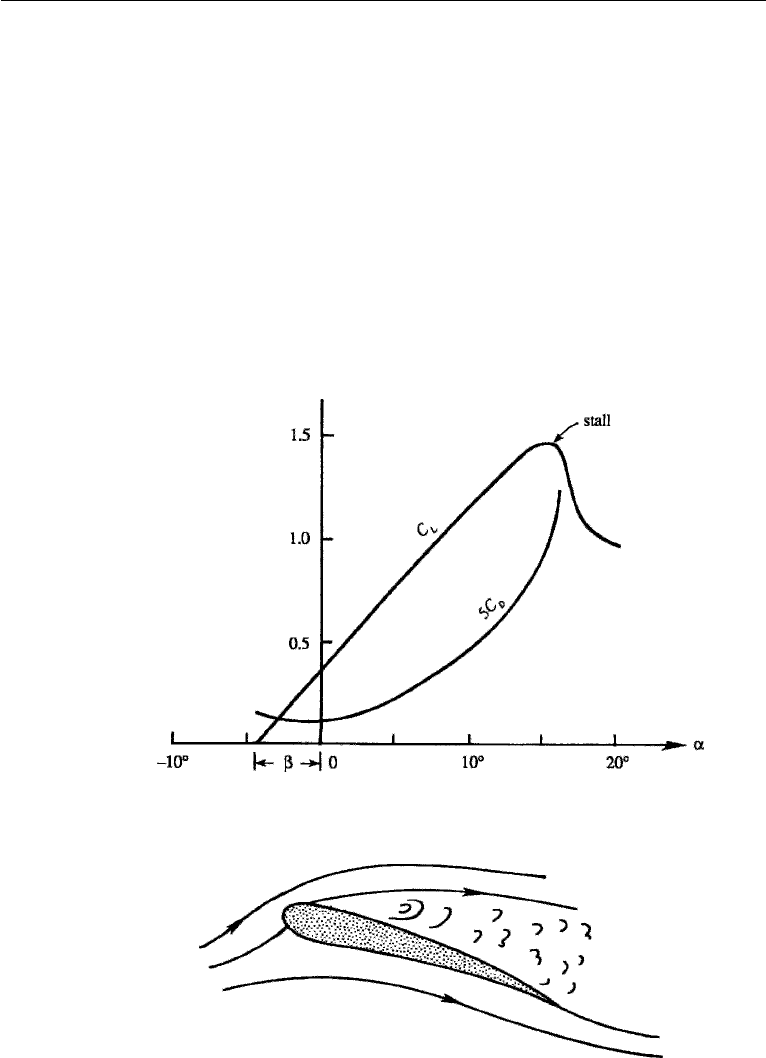
704 Aerodynamics
12. Lift and Drag Characteristics of Airfoils
Before an aircraft is built its wings are tested in a wind tunnel, and the results are
generally given as plots of C
L
and C
D
vs the angle of attack. A typical plot is shown in
Figure 15.26. It is seen that, in a range of incidence angle from α =−4
◦
to α = 12
◦
,
the variation of C
L
with α is approximately linear, a typical value of dC
L
/dα being
≈0.1 per degree. The lift reaches a maximum value at an incidence of ≈15
◦
. If the
angle of attack is increased further, the steep adverse pressure gradient on the upper
surface of the airfoil causes the flow to separate nearly at the leading edge, and a very
large wake is formed (Figure 15.27). The lift coefficient drops suddenly, and the wing
is said to stall. Beyond the stalling incidence the lift coefficient levels off again and
remains at ≈0.7–0.8 for fairly large angles of incidence.
The maximum lift coefficient depends largely on the Reynolds number Re. At
lower values of Re ∼ 10
5
–10
6
, the flow separates before the boundary layer undergoes
Figure 15.26 Lift and drag coefficients vs angle of attack.
Figure 15.27 Stalling of an airfoil.

12. Lift and Drag Characteristics of Airfoils 705
transition, and a very large wake is formed. This gives maximum lift coefficients <0.9.
At larger Reynolds numbers, say Re > 10
7
, the boundary layer undergoes transition
to turbulent flow before it separates. This produces a somewhat smaller wake, and
maximum lift coefficients of ≈1.4 are obtained.
The angle of attack at zero lift, denoted by −β here, is a function of the section
camber. (For a Zhukhovsky airfoil, β = 2(camber)/chord.) The effect of increasing
the airfoil camber is to raise the entire graph of C
L
vs α, thus increasing the maximum
values of C
L
without stalling. A cambered profile delays stalling essentially because
its leading edge points into the airstream while the rest of the airfoil is inclined to the
stream. Rounding the airfoil nose is very helpful, for an airfoil of zero thickness would
undergo separation at the leading edge. Trailing edge flaps act to increase the camber
when they are deployed. Then the maximum lift coefficient is increased, allowing for
lower landing speeds.
Various terms are in common usage to describe the different components of the
drag. The total drag of a body can be divided into a friction drag due to the tangential
stresses on the surface and pressure drag due to the normal stresses. The pressure
drag can be further subdivided into an induced drag and a form drag. The induced
drag is the “drag due to lift” and results from the work done by the body to supply
the kinetic energy of the downwash field as the trailing vortices increase in length.
The form drag is defined as the part of the total pressure drag that remains after
the induced drag is subtracted out. (Sometimes the skin friction and form drags are
grouped together and called the profile drag, which represents the drag due to the
“profile” alone and not due to the finiteness of the wing.) The form drag depends
strongly on the shape and orientation of the airfoil and can be minimized by good
design. In contrast, relatively little can be done about the induced drag if the aspect
ratio is fixed.
Normally the induced drag constitutes the major part of the total drag of a wing.
As C
D
i
is nearly proportional to C
2
L
, and C
L
is nearly proportional to α, it follows
that C
D
i
∝ α
2
. This is why the drag coefficient in Figure 15.26 seems to increase
quadratically with incidence.
For high-speed aircraft, the appearance of shock waves can adversely affect the
behavior of the lift and drag characteristics. In such cases the maximum flow speeds
can be close to or higher than the speed of sound even when the aircraft is fly-
ing at subsonic speeds. Shock waves can form when the local flow speed exceeds
the local speed of sound. To reduce their effect, the wings are given a sweepback
angle, as shown in Figure 15.2. The maximum flow speeds depend primarily on the
component of the oncoming stream perpendicular to the leading edge; this compo-
nent is reduced as a result of the sweepback. As a result, increased flight speeds are
achievable with highly swept wings. This is particularly true when the aircraft flies
at supersonic speeds, in which there is invariably a shock wave in front of the nose
of the fuselage, extending downstream in the form of a cone. Highly swept wings
are then used in order that the wing does not penetrate this shock wave. For flight
speeds exceeding Mach numbers of order 2, the wings have such large sweepback
angles that they resemble the Greek letter ; these wings are sometimes called delta
wings.
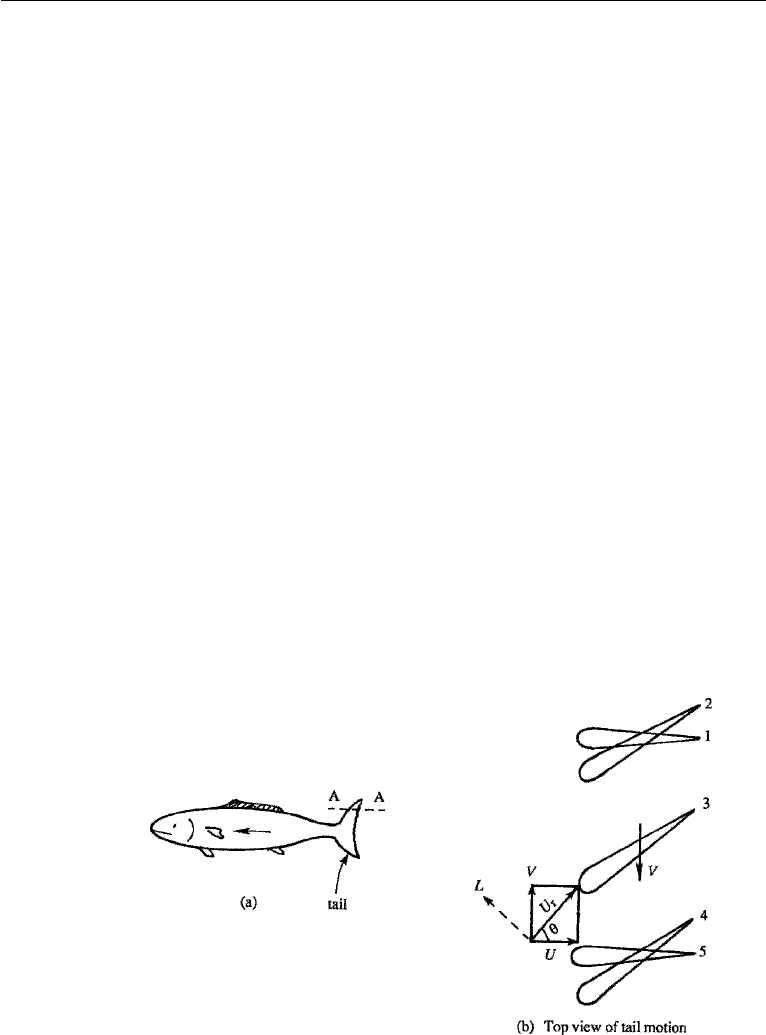
706 Aerodynamics
13. Propulsive Mechanisms of Fish and Birds
The propulsive mechanisms of many animals utilize the aerodynamic principle of lift
generation on winglike surfaces. We shall now describe some of the basic ideas of
this interesting subject, which is discussed in more detail by Lighthill (1986).
Locomotion of Fish
First consider the case of a fish. It develops a forward thrust by horizontally oscillating
its tail from side to side. The tail has a cross section resembling that of a symmetric
airfoil (Figure 15.28a). One-half of the oscillation is represented in Figure 15.28b,
which shows the top view of the tail. The sequence 1 to 5 represents the positions of
the tail during the tail’s motion to the left. A quick change of orientation occurs at one
extreme position of the oscillation during 1 to 2; the tail then moves to the left during 2
to 4, and another quick change of orientation occurs at the other extreme during 4 to 5.
Suppose the tail is moving to the left at speed V , and the fish is moving forward
at speed U. The fish controls these magnitudes so that the resultant fluid velocity U
r
(relative to the tail) is inclined to the tail surface at a positive “angle of attack.” The
resulting lift L is perpendicular to U
r
and has a forward component L sin θ. (It is easy
to verify that there is a similar forward propulsive force when the tail moves from left
to right.) This thrust, working at the rate UL sin θ, propels the fish. To achieve this
propulsion, the tail of the fish pushes sideways on the water against a force of L cos θ ,
which requires work at the rate VLcos θ .AsV/U = tan θ, ideally the conversion
of energy is perfect—all of the oscillatory work done by the fish tail goes into the
translational mode. In practice, however, this is not the case because of the presence
of induced drag and other effects that generate a wake.
Most fish stay afloat by controlling the buoyancy of a swim bladder inside their
stomach. In contrast, some large marine mammals such as whales and dolphins
Figure 15.28 Propulsion of fish. (a) Cross section of the tail along AA is a symmetric airfoil. Five
positions of the tail during its motion to the left are shown in (b). The lift force L is normal to the resultant
speed U
r
of water with respect to the tail.
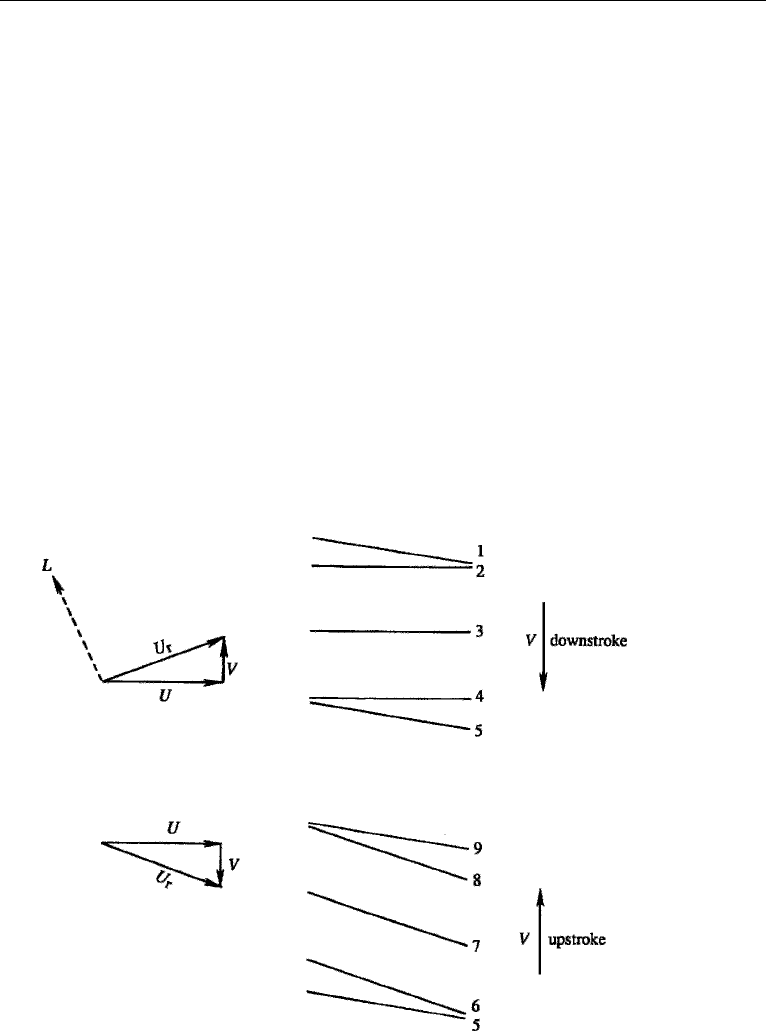
13. Propulsive Mechanisms of Fish and Birds 707
develop both a forward thrust and a vertical lift by moving their tails vertically.
They are able to do this because their tail surface is horizontal, in contrast to the ver-
tical tail shown in Figure 15.28. A recent review by Fish and Lauder (2006) provided
evidence that leading edge tubercles as seen on humpback whale flippers increase lift
and reduce drag at high angles of attack. This is because separation is delayed due
to the creation of streamwise vortices on the suction side. Cetacean flukes or flippers
and fish tail fins as well as dorsal and pectoral fins are flexible and can vary their
camber during a stroke. As a result they are very efficient propulsive devices.
Flight of Birds and Insects
Now consider the flight of birds, who flap their wings to generate both the lift to
support their body weight and the forward thrust to overcome the drag. Figure 15.29
shows a vertical section of the wing positions during the upstroke and downstroke
of the wing. (Birds have cambered wings, but this is not shown in the figure.) The
angle of inclination of the wing with the airstream changes suddenly at the end of each
stroke, as shown. The important point is that the upstroke is inclined at a greater angle
to the airstream than the downstroke. As the figure shows, the downstroke develops a
lift force L perpendicular to the resultant velocity of the air relative to the wing. Both
Figure 15.29 Propulsion of a bird. A cross section of the wing is shown during upstroke and downstroke.
During the downstroke, a lift force L acts normal to the resultant speed U
r
of air with respect to the wing.
During the upstroke, U
r
is nearly parallel to the wing and very little aerodynamic force is generated.

708 Aerodynamics
a forward thrust and an upward force result from the downstroke. In contrast, very
little aerodynamic force is developed during the upstroke, as the resultant velocity
is then nearly parallel to the wing. Birds therefore do most of the work during the
downstroke, and the upstroke is “easy.”
A recent study by Liu et al. (2006) provides the most complete description to date
of wing planform, camber, airfoil section, and spanwise twist distribution of seagulls,
mergansers, teals, and owls. Moreover, flapping as viewed by video images from free
flight was digitized and modeled by a two-jointed wing at the quarter chord point.
The data from this paper can be used to model the aerodynamics of bird flight.
Using previously measured kinematics and experiments on an approximately
100X upscaled model, Ramamurti and Sandberg (2001) calculated the flow about a
Drosophila (fruit fly) in flight. They matched Reynolds number (based on wing-tip
speed and average chord) and found that viscosity had negligible effect on thrust and
drag at a flight Reynolds number of 120. The wings were near elliptical plates with
axis ratio 3:1.2 and thickness about 1/80 of the span. Averaged over a cycle, the mean
thrust coefficient (thrust/[dynamic pressure × wing surface]) was 1.3 and the mean
drag coefficient close to 1.5.
14. Sailing against the Wind
People have sailed without the aid of an engine for thousands of years and have
known how to arrive at a destination against the wind. Actually, it is not possible
to sail exactly against the wind, but it is possible to sail at ≈40–45
◦
to the wind.
Figure 15.30 shows how this is made possible by the aerodynamic lift on the sail,
which is a piece of large stretched cloth. The wind speed is U , and the sailing speed
is V , so that the apparent wind speed relative to the boat is U
r
. If the sail is properly
oriented, this gives rise to a lift force perpendicular to U
r
and a drag force parallel to
U
r
. The resultant force F can be resolved into a driving component (thrust) along the
motion of the boat and a lateral component. The driving component performs work
in moving the boat; most of this work goes into overcoming the frictional drag and
in generating the gravity waves that radiate outward. The lateral component does not
cause much sideways drift because of the shape of the hull. It is clear that the thrust
decreases as the angle θ decreases and normally vanishes when θ is ≈40–45
◦
. The
energy for sailing comes from the wind field, which loses kinetic energy after passing
through the sail.
In the foregoing discussion we have not considered the hydrodynamic forces
exerted by the water on the hull. At constant sailing speed the net hydrodynamic force
must be equal and opposite to the net aerodynamic force on the sail. The hydrodynamic
force can be decomposed into a drag (parallel to the direction of motion) and a
lift. The lift is provided by the “keel,” which is a thin vertical surface extending
downward from the bottom of the hull. For the keel to act as a lifting surface, the
longitudinal axis of the boat points at a small angle to the direction of motion of the
boat, as indicated near the bottom right part of Figure 15.30. This “angle of attack”
is generally <3
◦
and is not noticeable. The hydrodynamic lift developed by the keel
opposes the aerodynamic lateral force on the sail. It is clear that without the keel the
lateral aerodynamic force on the sail would topple the boat around its longitudinal axis.
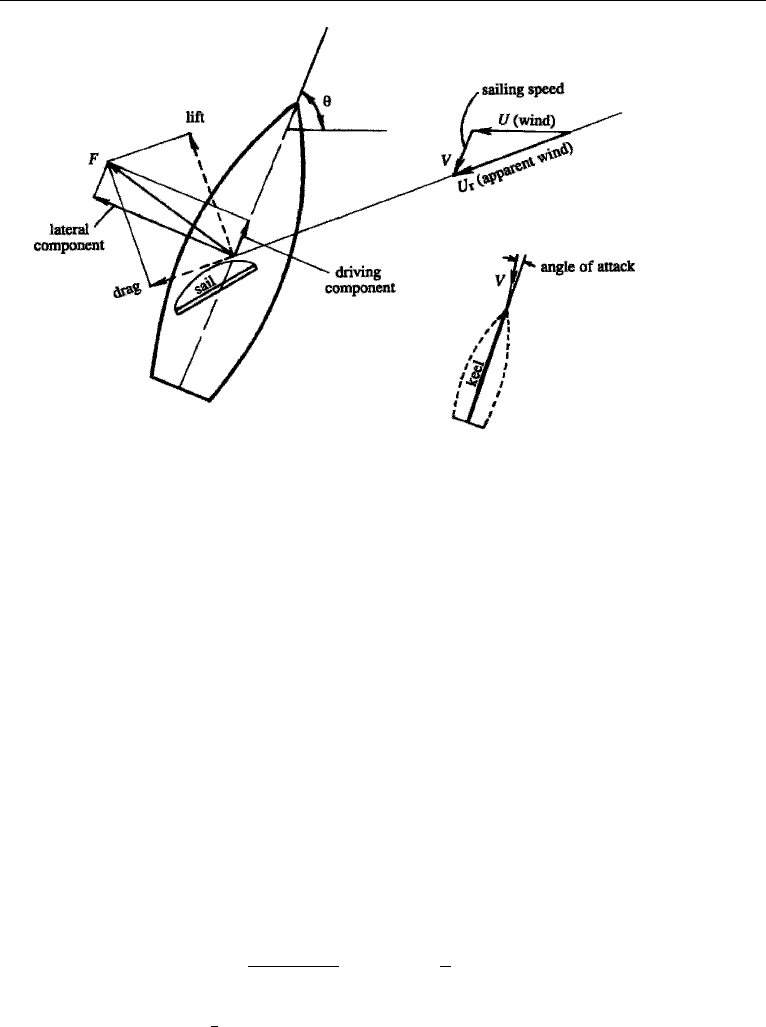
Exercises 709
Figure 15.30 Principle of a sailboat.
To arrive at a destination directly against the wind, one has to sail in a zig-zag
path, always maintaining an angle of ≈45
◦
to the wind. For example, if the wind is
coming from the east, we can first proceed northeastward as shown, then change the
orientation of the sail to proceed southeastward, and so on. In practice, a combination
of a number of sails is used for effective maneuvering. The mechanics of sailing
yachts is discussed in Herreshoff and Newman (1966).
Exercises
1. Consider an airfoil section in the xy-plane, the x-axis being aligned with the
chordline. Examine the pressure forces on an element ds = (dx, dy) on the surface,
and show that the net force (per unit span) in the y-direction is
F
y
=−
c
0
p
u
dx +
c
0
p
l
dx,
where p
u
and p
l
are the pressures on the upper and the lower surfaces and c is the
chord length. Show that this relation can be rearranged in the form
C
y
≡
F
y
(1/2)ρU
2
c
=
C
p
d
x
c
,
where C
p
≡ (p − p
∞
)/(
1
2
ρU
2
), and the integral represents the area enclosed in a
C
p
vs x/c diagram, such as Figure 15.8. Neglect shear stresses. [Note that C
y
is not
exactly the lift coefficient, since the airstream is inclined at a small angle α with the
x-axis.]

710 Aerodynamics
2. The measured pressure distribution over a section of a two-dimensional airfoil
at 4
◦
incidence has the following form:
Upper Surface: C
p
is constant at −0.8 from the leading edge to a distance
equal to 60% of chord and then increases linearly to 0.1 at the trailing edge.
Lower Surface: C
p
is constant at −0.4 from the leading edge to a distance
equal to 60% of chord and then increases linearly to 0.1 at the trailing edge.
Using the results of Exercise 1, show that the lift coefficient is nearly 0.32.
3. The Zhukhovsky transformation z = ζ + b
2
/ζ transforms a circle of radius
b, centered at the origin of the ζ -plane, into a flat plate of length 4b in the z-plane.
The circulation around the cylinder is such that the Kutta condition is satisfied at the
trailing edge of the flat plate. If the plate is inclined at an angle α to a uniform stream
U, show that
(i) The complex velocity in the ζ -plane is
w = U
ζe
−iα
+
1
ζ
b
2
e
iα
+
i
2π
ln (ζ e
−iα
),
where = 4πUb sin α. Note that this represents flow over a circular cylinder
with circulation, in which the oncoming velocity is oriented at an angle α.
(ii) The velocity components at point P (−2b, 0) in the ζ -plane are [
3
4
U cos α,
9
4
U sin α].
(iii) The coordinates of the transformed point P
in the xy-plane are [−5b/2, 0].
(iv) The velocity components at [−5b/2, 0]in the xy-plane are [U cos α,3U sin α].
4. In Figure 15.13, the angle at A
has been marked 2β. Prove this. [Hint : Locate
the center of the circular arc in the z-plane.]
5. Consider a cambered Zhukhovsky airfoil determined by the following
parameters:
a = 1.1,
b = 1.0,
β = 0.1.
Using a computer, plot its contour by evaluating the Zhukhovsky transformation. Also
plot a few streamlines, assuming an angle of attack of 5
◦
.
6. A thin Zhukhovsky airfoil has a lift coefficient of 0.3 at zero incidence. What
is the lift coefficient at 5
◦
incidence?
7. An untwisted elliptic wing of 20-m span supports a weight of 80,000 N in a
level flight at 300 km/hr. Assuming sea level conditions, find (i) the induced drag and
(ii) the circulation around sections halfway along each wing.

Literature Cited 711
8. The circulation across the span of a wing follows the parabolic law
=
0
1 −
4y
2
s
2
Calculate the induced velocity w at midspan, and compare the value with that obtained
when the distribution is elliptic.
Literature Cited
Anderson, John D., Jr. (1998). A History of Aerodynamics, London: Cambridge University Press.
Anderson, John D., Jr. (2007). Fundamentals of Aerodynamics, New York: McGraw-Hill.
Ashley, H. and M. Landahl (1965). Aerodynamics of Wings and Bodies, Reading, MA: Addison-Wesley.
Fish, F. E. and G. V. Lauder (2006). “Passive and Active Control by Swimming Fishes and Mammals.”
Annual Rev. Fluid Mech. 38: 193–224.
Hawking, S. W. (1988). A Brief History of Time, New York: Bantam Books.
Herreshoff, H. C. and J. N. Newman (1986). “The study of sailing yachts.” Scientific American 215 (August
issue): 61–68.
von Karman, T. (1954). Aerodynamics, New York: McGraw-Hill. (A delightful little book, written for the
nonspecialist, full of historical anecdotes and at the same time explaining aerodynamics in the easiest
way.)
Kuethe, A. M. and C. Y. Chow (1998). Foundations of Aerodynamics: Basis of Aerodynamic Design,
New York: Wiley.
Lighthill, M. J. (1986). An Informal Introduction to Theoretical Fluid Mechanics, Oxford, England:
Clarendon Press.
Liu, T., K. Kuykendoll, R. Rhew, and S. Jones (2006). “Avian Wing Geometry and Kinematics.” AIAA J.
44: 954–963.
Ramamurti, R. and W. C. Sandberg (2001). “Computational Study of 3-D Flapping Foil Flows.” AIAA
Paper 2001–0605.
Supplemental Reading
Batchelor, G. K. (1967). An Introduction to Fluid Dynamics, London: Cambridge University Press.
Karamcheti, K. (1980). Principles of Ideal-Fluid Aerodynamics, Melbourne, FL: Krieger Publishing Co.
Prandtl, L. (1952). Essentials of Fluid Dynamics, London: Blackie & Sons Ltd. (This is the English edition
of the original German edition. It is very easy to understand, and much of it is still relevant today.)
Printed in New York by Hafner Publishing Co. If this is unavailable, see the following reprints in
paperback that contain much if not all of this material:
Prandtl, L. and O. G. Tietjens (1934) [original publication date]. Fundamentals of Hydro and Aero-
mechanics, New York: Dover Publ. Co.; and
Prandtl, L. and O. G. Tietjens (1934) [original publication date]. Applied Hydro and Aeromechanics,
New York: Dover Publ. Co. This contains many original flow photographs from Prandtl’s laboratory.
